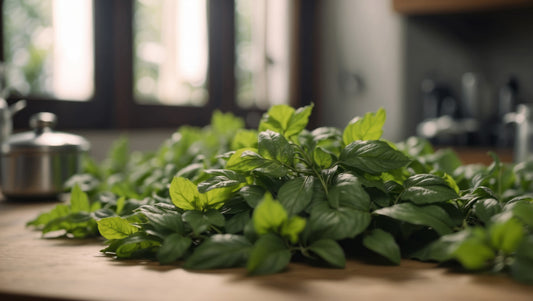Laurie Dohmen, VMD, MS, RH(AHG), FACVBM
It’s finally springtime! Time to renew and reawaken our bodies and those of our pets. In our last blog, we talked about following a daily schedule, but we should also follow a seasonal schedule. We get quieter, slower and eat heavier foods in the winter. So in the spring, we need to shed the sludge we acquire over the winter. We do this by exercising more, and changing our diet and herbs to lighter, more bitter flavors. This a great time to consider adding some safe, well-chopped, dark leafy greens to your pets’ food and practice regular movement and play. Also, it can be beneficial to use herbs to refresh the liver (where all our winter choices accumulate) and flush toxins out. Our pets need this as much as we do.
So, how do spring cleanses work?
To understand how a spring cleanse works, we need to understand digestion a little better. Here’s a very simple explanation of digestion:
- The official digestive tract consists of the mouth, esophagus, stomach, small and large intestines and then the anus. These organs are primarily holding vessels that also do mechanical work of churning and squeezing (peristalsis) to break up food and move it through the tract.
- The enzymes that do the real work of breaking down food into pieces our cells can use come primarily from the liver and pancreas. Additionally, the liver and the kidneys filter the blood and remove toxins.
- The toxins from the liver are deposited in the intestines to be removed in the feces and the kidney toxins are removed in urine.
One set of common springtime toxins we are all exposed to is pollen. Pollen is cleared through the liver, so anything that supports the liver supports our sinuses! Many herbs that affect the liver also affect seasonal flexibility. All the toxins we are exposed to are processed through our immune systems, so herbs that support our immunity are also helpful in ridding the body of toxins. Now, let's talk herbs.
Guduchi, the Heavenly Elixir:

One great herb for springtime cleansing is Guduchi (Tinospora cordifolia). Guduchi is a Hindi description of a “heavenly elixir” that keeps people “eternally young” (1) (2). “It is supposed to be the ambrosia of God Indra, considered a holy liquid” (3). In Ayurveda, Guduchi is used as “a panacea for almost all diseases and disorders” and a rasayana (3).
How does Guduchi work?
This herb is beneficial to the immune system, which is why it is so broadly helpful in both times of immune stress, as well as offering support when the immune system is overworked. Guduchi has long been used for upper respiratory comfort, and all parts of this plant have been traditionally used to encourage internal cleansing via the digestive tract. This cleansing may include liver support and as well as stimulation of the digestive process.
In ruminants like cows or sheep, this plant is even used traditionally as an appetizer (1). Appetizers were actually invented to stimulate the release of digestive enzymes, so the digestive tract was ready for the meal it was about to receive. Guduchi helps the body to retain vitamins so they are not excreted excessively (2). It does contain berberines, which can negatively affect vitamin B absorption, so appropriate dosing is very important.
Kutki, a Traditional Protector:

Kutki (Picrorhiza kurroa) roots have been used as herbal support since the beginnings of Ayurveda as a medical tradition (4). Picrorhiza is Greek for “bitter root” (4). It was traditionally used as an appetizer in pigs (1). This root has long been used to support and protect the liver, no matter the cause of the stress.
How does Kutki work?
If the liver is overburdened, it is not as able to remove toxins, causing them to build up in our blood, and ultimately in many of the cells in our bodies. So, it is crucial to keep our livers functioning at prime capacity. In fact, in a review of kukti, the authors stated: “the hepatoprotective and health-promoting characteristics of P. kurroa may improve health and family income globally” (4). Feeling better makes all mammals function better, which increases health and productivity.
Another advantage of kutki is that it tones the digestive system and peristalsis; it supports flushing of the digestive system, literally emptying anything that has built up along the tract. While dogs are not as prone to respiratory congestion, often associated with pollen as humans (dogs manifest their reactions in their skin and ears primarily), the link between pollen and the liver has been seen with this herb as it was traditionally used for liver and respiratory health in humans. It is very supportive for cats and helps them maintain a healthy respiratory tract. Kukti also supports the immune system so that it is ready and able to deal with any common challenges.
While kutki is found to be generally safe, it is extremely bitter, so it is best administered in capsules. Unfortunately, kutki is an endangered plant, so it is best used from sources that are growing and harvesting it sustainably.
Remember, spring is a great time to cleanse:
There are a plethora of herbs and foods that support the liver, the immune system, and a spring cleanse, including leafy greens, they count as herbs too! Food is a great place to start, but as the seasons change, it is nice to punch the cleanse up with some targeted herbs, such as guduchi and kutki. You and your pets will enjoy the benefits and energy cleansing provides!
References:
- Williamson, E. Major Herbs of Ayurveda. Edinburgh : Churchill Livingstone, 2002.
- Therapeutic Application, Phytoactives and Pharmacology of Tinospora cordifolia: An Evocative Review. Ahsan, R, et al. 6, 2023, Chinese Journal of Integrative Medicine, Vol. 29, pp. 249-555.
- TInospora cordifolia (Giloy): An Insight on the Multifarious Pharmacological Paradigms of a Most Promising Medicinal Ayurvedic Herb. Gupta, A, Gupta, P and Bajpai, G. 2024, Heliyon, Vol. 10, p. e26125.
- Pharmacological and Clinical Efficacy of Picrorhiza kurroa and its Secondary Metabolites: A Comprehensive Review. Almeleebia, T, Alsayari, A and Wahab, S. 23, 2022, Molecules, Vol. 27, p. 8316.
- Sodhi, Virender. Ayurvedic Herbs. Bothell, WA : Book Publishers Network, 2014.




